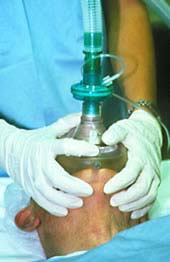Pain blockers blocked post op

Chemical cage may help post-op patients come round. <br>© SPL <br>
New molecule wraps up excess anaesthetic.
Recovering from anaesthesia could become much easier if a new drug, now in clinical trials, lives up to its potential1.
During some operations, patients receive neuromuscular blockers to suppress voluntary or reflex muscle contractions. After surgery, they are given drugs to negate the blockers’ influence and restore normal muscle function. These often have nasty side-effects, including vomiting, cramps and diarrhoea. Drugs that alleviate these side-effects have unwelcome consequences of their own, such as dry mouth and blurred vision.
The problem is that whereas blockers do one thing, their antagonists don’t simply do the opposite, but rather they have more general effects. It’s like trying to prevent credit-card fraud by outlawing credit cards.
Far better is to round up only those cards that are being used fraudulently, reasoned Ming-Qiang Zhang of Organon Laboratories Ltd in Newhouse, Scotland, and colleagues. They have created a molecule that recognizes neuromuscular blockers and wraps them up, thereby deactivating them.
It’s a wrap
The team worked with the common blocker rocuronium (sold as Zemuron in the United States). This is a steroid molecule with a rigid, fat-soluble atomic framework.
To suppress the blocker’s physiological effects, Zhang’s group designed a ring-shaped sugar molecule, called a cyclodextrin, to encase it. This harmless, water-soluble molecule has a water-friendly rim and a fat-friendly inner cavity.
The researchers modified a natural cyclodextrin in two ways to make it a better cage for rocuronium. They made the cavity deeper and added molecular groups around the rim, which form chemical bonds with groups on an encapsulated rocuronium molecule.
The resulting cyclodextrin, called Org25969, reverses rocuronium’s effects quickly and efficiently, by binding tightly to it and nothing else.
In anaesthetized Rhesus monkeys treated with rocuronium, Org25969 produces almost full muscle recovery within three minutes of being administered. This is faster than standard antagonist drugs and is accompanied by none of the usual side-effects, such as increased heart rate. Org25969 is now undergoing clinical trials in humans.
References
- Bom, A. et al. A novel concept of reversing neuromuscular block: chemical encapsulation of rocuronium bromide by a cyclodextrin-based synthetic host. Angewandte Chemie International Edition, 41, 266 – 270, (2002).
Media Contact
Weitere Informationen:
http://www.nature.com/nsu/020114/020114-5.htmlAlle Nachrichten aus der Kategorie: Medizin Gesundheit
Dieser Fachbereich fasst die Vielzahl der medizinischen Fachrichtungen aus dem Bereich der Humanmedizin zusammen.
Unter anderem finden Sie hier Berichte aus den Teilbereichen: Anästhesiologie, Anatomie, Chirurgie, Humangenetik, Hygiene und Umweltmedizin, Innere Medizin, Neurologie, Pharmakologie, Physiologie, Urologie oder Zahnmedizin.
Neueste Beiträge

Du bist, was du isst – Stanford-Studie verbindet Ballaststoffe mit Modulation von Anti-Krebs-Genen
Die Ballaststofflücke: Ein wachsendes Problem in der amerikanischen Ernährung Ballaststoffe sind bekanntlich ein wichtiger Bestandteil einer gesunden Ernährung, doch weniger als 10 % der Amerikaner konsumieren die empfohlene Mindestmenge. Eine…

Vertrauen Sie Ihrem Bauchgefühl – RNA-Protein-Entdeckung für eine bessere Immunität
HIRI-Forscher entschlüsseln Kontrollmechanismen der Polysaccharidverwertung in Bacteroides thetaiotaomicron. Forschende des Helmholtz-Instituts für RNA-basierte Infektionsforschung (HIRI) und der Julius-Maximilians-Universität (JMU) Würzburg haben ein Protein sowie eine Gruppe kleiner Ribonukleinsäuren (sRNAs) in…

ASXL1-Mutation: Der verborgene Auslöser hinter Blutkrebs und Entzündungen
Wissenschaftler zeigen, wie ein mutiertes Gen rote und weiße Blutkörperchen schädigt. LA JOLLA, CA – Wissenschaftler am La Jolla Institute for Immunology (LJI) haben herausgefunden, wie ein mutiertes Gen eine…



